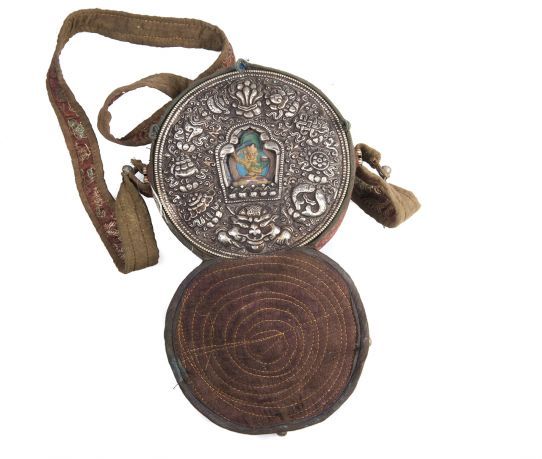We use cookies to make your experience better.
Tibetan travel altar called GAU (about 14 cm)
A Tibetan gau is mostly metal, small shrine altar, portable reliquary, or a container for relics ofamuletten for a necklace or in the hair. A gau may consist of a small statue of a Tibetan deity or a Buddha or similar representations, such as miniature paintings which are called Tibetan Tsakli. The small statues can be made from metal, wood or stone; a clay statuette created called tsatsa using molds. The latter can be done by high-vajrayana llamas dedicated, or the clay can be mixed with the axis of a deceased lama. In a gau may relics such as bone parts, hair, fragments of clothing of deceased teachers, religious text portions ofgeneeskrachtige herbs are stored. Also, metal amulets called thokcha can be in a gau, gau A normally consists of two parts and is composed of the nature of the casket. The front is mostly with copper foil, or -silver -gold edited and can be further embellished with jewel stones like corals enturkooizen or pearls. It usually carries a representation of a Buddha or Buddhist deity symbol of luck and exhibits at the larger ones in the middle window. The back is usually made of copper and may have inscriptions of religious symbols. Larger specimens are rectangular and the upper portion generally arcing protrudes upwards, while the smaller ones square, polygonal or round and are worn on a necklace, or with a buckle in the hair. The larger, portable gau is used on the altar. Even nomads tend to have the portable gau, but they are also on the tabernacle altar. The portable ones are worn with a fabric or leather strap over the shoulder so that they hang on the side or behind the body. This way of wearing the gauss is especially much smaller in use during bedevaarten.De copies can be continuously worn on the neck or in the hair. They are made of precious materials and are worn with holidays.
Tibet (Tibetan: བོད་, Bod) is a geographic area and a former independent state on the Tibetan Highlands. It has historically its own people, culture, language and two religions: the Bon and Tibetan Buddhism. Since the 1950-51 invasion of Tibet, it has been part of the People's Republic of China and has been divided into a number of Chinese provinces, including the entire Tibet Autonomous Region and parts of Sichuan and Qinghai. Culturally, Ladakh and Sikkim are also counted in India, Bhutan and some parts of Nepal to Tibet. The Tibet Autonomous Region is bordered to the south and west by Nepal, Bhutan, Myanmar and the Indian states of Jammu and Kashmir and Himachal Pradesh, Sikkim, Arunachal Pradesh. From north to east it borders on the provinces of Sinkiang (Turkestan), Gansu, Sichuan and Yunnan. Until 1950, when the People's Liberation Army invaded Tibet, Tibet was an independent country, with a theocratic government. In the far corners of Tibet, power was in the hands of local warlords. Before 1950, the most important religious and political leader was the fourteenth Dalai Lama Tenzin Gyatso. In 1959 he fled to India, where he led the government into exile until the democratic reforms of 2000.












